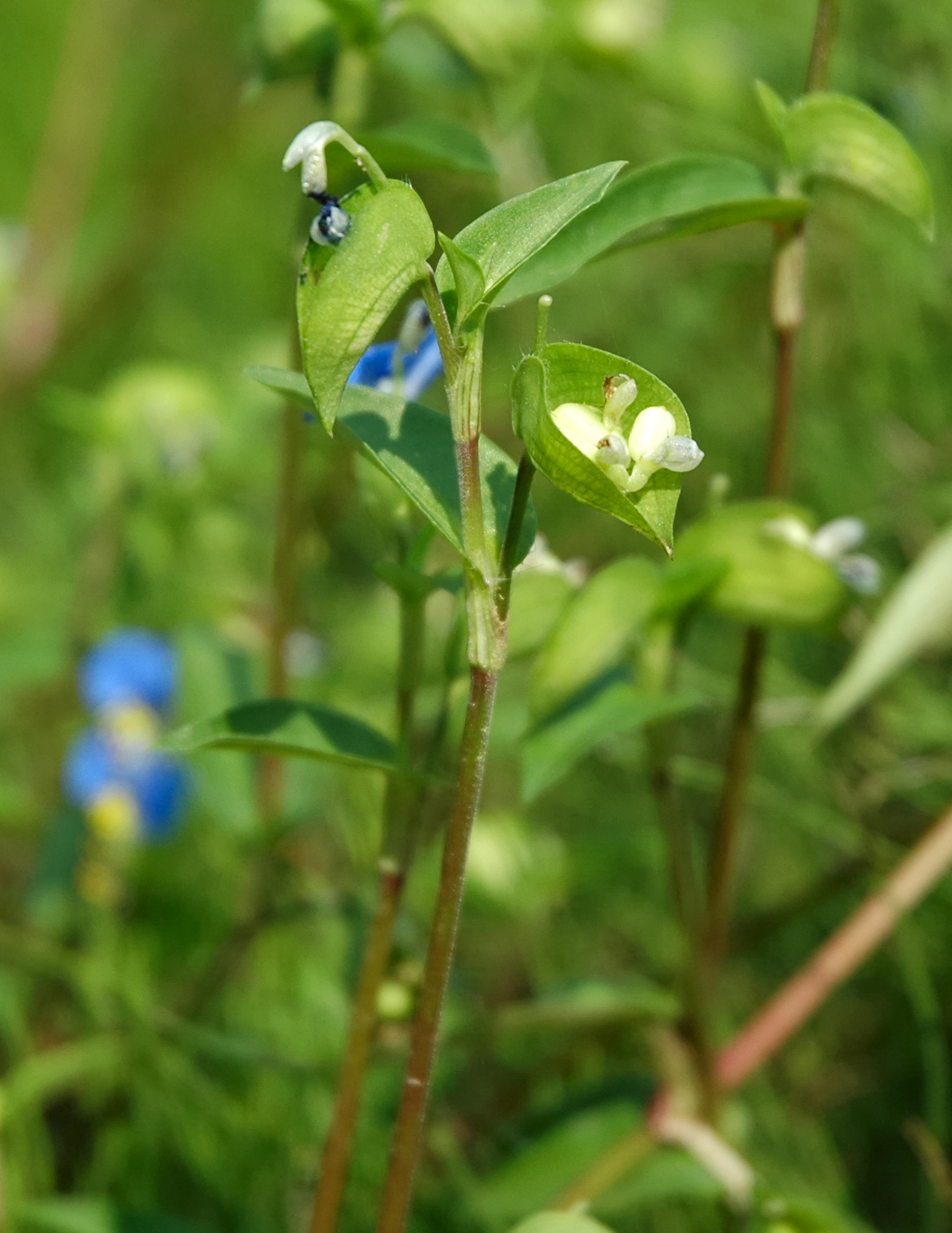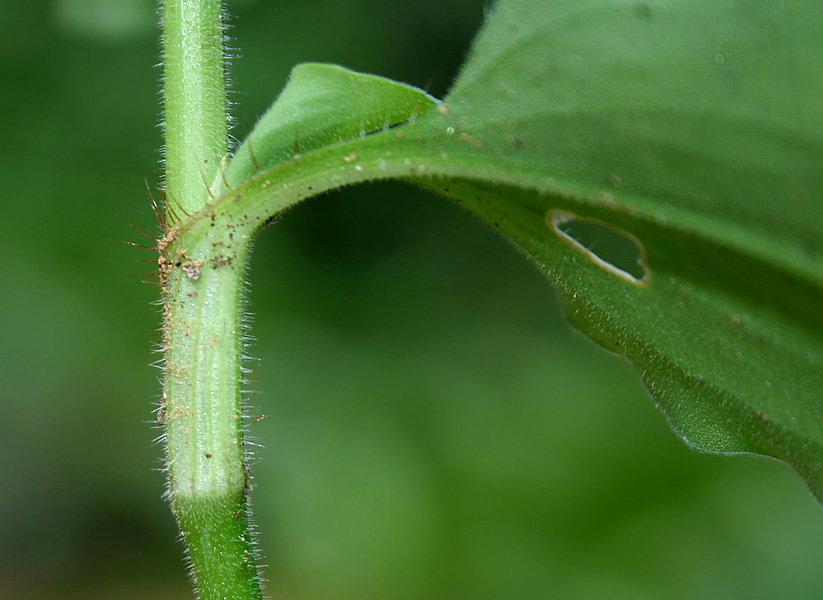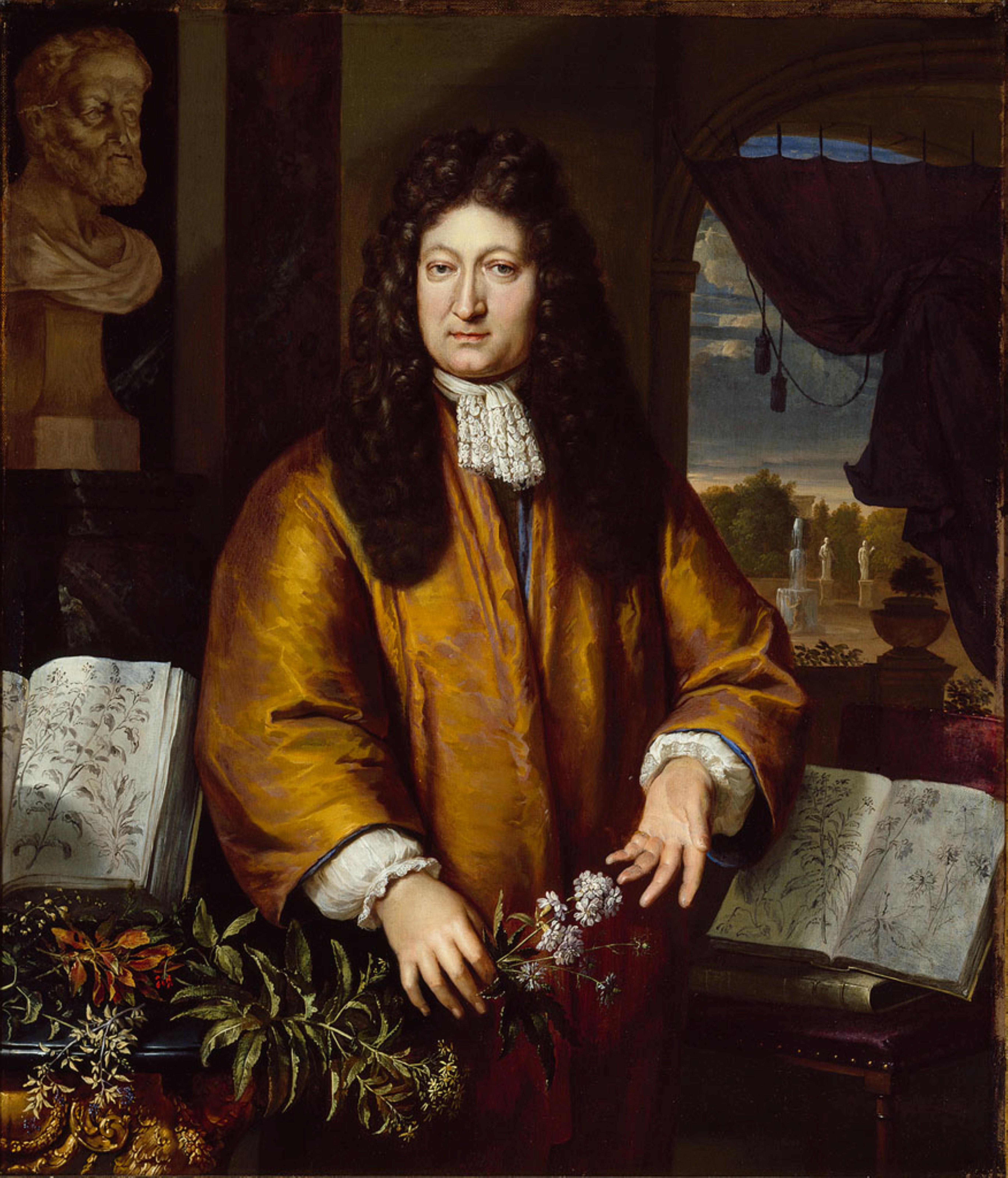|
Commelina
''Commelina'' is a genus of approximately 170 species commonly called dayflowers due to the short lives of their flowers. They are less often known as widow's tears. It is by far the largest genus of its family, Commelinaceae. The Swedish taxonomist Carl Linnaeus of the 18th century named the genus after the two Dutch botanists Jan Commelijn and his nephew Caspar, each representing one of the showy petals of ''Commelina communis''. The dayflowers are herbs that may be either perennial or annual. They are characterised by their zygomorphic flowers and by the involucral bracts called spathes that surround the flower stalks. These spathes are often filled with a mucilaginous liquid. Each spathe houses either one or two scorpioid cymes, with the upper cyme being either vestigial or bearing from one to several typically male flowers, and the lower cyme bearing several flowers. All members of the genus have alternate leaves. The Asiatic dayflower (''Commelina communis'') is probably th ... [...More Info...] [...Related Items...] OR: [Wikipedia] [Google] [Baidu] |
List Of Commelina Species
This is an alphabetically ordered list of ''Commelina'' species. The list includes all species accepted by the ''World Checklist of Selected Plant Families''. A *'' Commelina acutispatha'' De Wild. *'' Commelina acutissima'' Urb. *'' Commelina africana'' L. *'' Commelina agrostophylla'' F.Muell. *'' Commelina albescens'' Hassk. *'' Commelina albiflora'' Faden *'' Commelina amplexicaulis'' Hassk. *'' Commelina appendiculata'' C.B.Clarke *'' Commelina arenicola'' Faden *'' Commelina ascendens'' J.K.Morton *'' Commelina aspera'' G.Don ex Benth. *'' Commelina attenuata'' K.D.Koenig ex Vahl *'' Commelina aurantiiflora'' Faden & Raynsf. *'' Commelina auriculata'' Blume *'' Commelina avenifolia'' J.Graham B *'' Commelina bambusifolia'' Matuda *'' Commelina bambusifolioides'' Matuda *'' Commelina bangii'' Rusby *'' Commelina barbata'' Lam. *'' Commelina beccariana'' Martelli *'' Commelina bella'' Oberm. *''Commelina benghalensis'' L. *'' Commelina bequaertii'' De Wild. *' ... [...More Info...] [...Related Items...] OR: [Wikipedia] [Google] [Baidu] |
Commelina Communis
''Commelina communis'', commonly known as the Asiatic dayflower, is an herbaceous annual plant in the dayflower family. It gets its name because the blooms last for only one day. It is native throughout much of East Asia and northern parts of Southeast Asia. In China, the plant is known as ''yazhicao'' (), roughly translating to "duckfoot herb", while in Japan it is known as , meaning "dew herb". It has also been introduced to parts of central and southeastern Europe and much of eastern North America, where it has spread to become a noxious weed. It is common in disturbed sites and in moist soil. The flowers emerge from summer through fall and are distinctive with two relatively large blue petals and one very small white petal. The Asiatic dayflower plant serves as the type species for its large genus. Linnaeus picked the name ''Commelina'' in honour of the two Dutch botanists of the Commelijn family, using the two large showy petals of ''Commelina communis'' to symbolise ... [...More Info...] [...Related Items...] OR: [Wikipedia] [Google] [Baidu] |
Commelina Benghalensis
''Commelina benghalensis'', commonly known as the Benghal dayflower, tropical spiderwort, or wandering Jew, ''kanshira'' in Bengali, is a perennial herb native to tropical Asia and Africa. It has been widely introduced to areas outside its native range, including to the neotropics, Hawaii, the West Indies and to both coasts of North America. It has a long flowering period, from spring to fall in subtropical areas, and throughout the year closer to the equator. It is often associated with disturbed soils. In both it native range and areas where it has been introduced it is usually considered a weed, sometimes a serious one. In the United States it has been placed on the Federal Noxious Weed List. It is considered a moderate weed of rice cultivation in Asia. In its native range of sub-Saharan Africa, India, Sri Lanka, and much of Southeast Asia, it is considered a serious weed of an enormous range of crops from tea and coffee to cassava and peanuts. Additional agricultural damage ... [...More Info...] [...Related Items...] OR: [Wikipedia] [Google] [Baidu] |
Commelinaceae
Commelinaceae is a family of flowering plants. In less formal contexts, the group is referred to as the dayflower family or spiderwort family. It is one of five families in the order Commelinales and by far the largest of these with about 731 known species in 41 genera. Well known genera include ''Commelina'' (dayflowers) and '' Tradescantia'' (spiderworts). The family is diverse in both the Old World tropics and the New World tropics, with some genera present in both. The variation in morphology, especially that of the flower and inflorescence, is considered to be exceptionally high amongst the angiosperms. The family has always been recognized by most taxonomists. The APG III system of 2009 (unchanged from the APG system of 1998), also recognizes this family, and assigns it to the order Commelinales in the clade commelinids in the monocots. The family counts several hundred species of herbaceous plants. Many are cultivated as ornamentals. The stems of these plants are genera ... [...More Info...] [...Related Items...] OR: [Wikipedia] [Google] [Baidu] |
Commelina Coelestis - Floral Diagram
''Commelina'' is a genus of approximately 170 species commonly called dayflowers due to the short lives of their flowers. They are less often known as widow's tears. It is by far the largest genus of its family, Commelinaceae. The Swedish taxonomist Carl Linnaeus of the 18th century named the genus after the two Dutch botanists Jan Commelijn and his nephew Caspar, each representing one of the showy petals of ''Commelina communis''. The dayflowers are herbs that may be either perennial or annual. They are characterised by their zygomorphic flowers and by the involucral bracts called spathes that surround the flower stalks. These spathes are often filled with a mucilaginous liquid. Each spathe houses either one or two scorpioid cymes, with the upper cyme being either vestigial or bearing from one to several typically male flowers, and the lower cyme bearing several flowers. All members of the genus have alternate leaves. The Asiatic dayflower (''Commelina communis'') is proba ... [...More Info...] [...Related Items...] OR: [Wikipedia] [Google] [Baidu] |
Stamen
The stamen (plural ''stamina'' or ''stamens'') is the pollen-producing reproductive organ of a flower. Collectively the stamens form the androecium., p. 10 Morphology and terminology A stamen typically consists of a stalk called the filament and an anther which contains '' microsporangia''. Most commonly anthers are two-lobed and are attached to the filament either at the base or in the middle area of the anther. The sterile tissue between the lobes is called the connective, an extension of the filament containing conducting strands. It can be seen as an extension on the dorsal side of the anther. A pollen grain develops from a microspore in the microsporangium and contains the male gametophyte. The stamens in a flower are collectively called the androecium. The androecium can consist of as few as one-half stamen (i.e. a single locule) as in '' Canna'' species or as many as 3,482 stamens which have been counted in the saguaro (''Carnegiea gigantea''). The androecium in ... [...More Info...] [...Related Items...] OR: [Wikipedia] [Google] [Baidu] |
Cyme (botany)
An inflorescence is a group or cluster of flowers arranged on a stem that is composed of a main branch or a complicated arrangement of branches. Morphologically, it is the modified part of the shoot of seed plants where flowers are formed on the axis of a plant. The modifications can involve the length and the nature of the internodes and the phyllotaxis, as well as variations in the proportions, compressions, swellings, adnations, connations and reduction of main and secondary axes. One can also define an inflorescence as the reproductive portion of a plant that bears a cluster of flowers in a specific pattern. The stem holding the whole inflorescence is called a peduncle. The major axis (incorrectly referred to as the main stem) above the peduncle bearing the flowers or secondary branches is called the rachis. The stalk of each flower in the inflorescence is called a pedicel. A flower that is not part of an inflorescence is called a solitary flower and its stalk i ... [...More Info...] [...Related Items...] OR: [Wikipedia] [Google] [Baidu] |
Inflorescence
An inflorescence is a group or cluster of flowers arranged on a Plant stem, stem that is composed of a main branch or a complicated arrangement of branches. Morphology (biology), Morphologically, it is the modified part of the shoot of spermatophyte, seed plants where flowers are formed on the axis of a plant. The modifications can involve the length and the nature of the internode (botany), internodes and the phyllotaxis, as well as variations in the proportions, compressions, swellings, adnations, connations and reduction of main and secondary axes. One can also define an inflorescence as the reproductive portion of a plant that bears a cluster of flowers in a specific pattern. The stem holding the whole inflorescence is called a Peduncle (botany), peduncle. The major axis (incorrectly referred to as the main stem) above the peduncle bearing the flowers or secondary branches is called the rachis. The stalk of each flower in the inflorescence is called a Pedicel (botany) , ... [...More Info...] [...Related Items...] OR: [Wikipedia] [Google] [Baidu] |
Bract
In botany, a bract is a modified or specialized leaf, especially one associated with a reproductive structure such as a flower, inflorescence axis or cone scale. Bracts are usually different from foliage leaves. They may be smaller, larger, or of a different color, shape, or texture. Typically, they also look different from the parts of the flower, such as the petals or sepals. A plant having bracts is referred to as bracteate or bracteolate, while one that lacks them is referred to as ebracteate and ebracteolate, without bracts. Variants Some bracts are brightly-coloured and serve the function of attracting pollinators, either together with the perianth or instead of it. Examples of this type of bract include those of '' Euphorbia pulcherrima'' (poinsettia) and ''Bougainvillea'': both of these have large colourful bracts surrounding much smaller, less colourful flowers. In grasses, each floret (flower) is enclosed in a pair of papery bracts, called the lemma (lower bract) and ... [...More Info...] [...Related Items...] OR: [Wikipedia] [Google] [Baidu] |
Spathe
In botany, a bract is a modified or specialized leaf, especially one associated with a reproductive structure such as a flower, inflorescence axis or cone scale. Bracts are usually different from foliage leaves. They may be smaller, larger, or of a different color, shape, or texture. Typically, they also look different from the parts of the flower, such as the petals or sepals. A plant having bracts is referred to as bracteate or bracteolate, while one that lacks them is referred to as ebracteate and ebracteolate, without bracts. Variants Some bracts are brightly-coloured and serve the function of attracting pollinators, either together with the perianth or instead of it. Examples of this type of bract include those of ''Euphorbia pulcherrima'' (poinsettia) and ''Bougainvillea'': both of these have large colourful bracts surrounding much smaller, less colourful flowers. In grasses, each floret (flower) is enclosed in a pair of papery bracts, called the lemma (lower bract) and p ... [...More Info...] [...Related Items...] OR: [Wikipedia] [Google] [Baidu] |
Jan Commelijn
Jan Commelin (23 April 1629 – 19 January 1692), also known as Jan Commelijn, Johannes Commelin or Johannes Commelinus, was a botanist, and was the son of historian Isaac Commelin; his brother Casparus was a bookseller and newspaper publisher. Jan became a professor of botany when many plants were imported from the Cape and Ceylon and a new system had to be developed. As alderman of the city, together with burgomaster Johan Huydecoper van Maarsseveen he led the arrangement of the new botanic garden Hortus Medicus, later becoming Hortus Botanicus. He cultivated exotic plants on his farm 'Zuyderhout' near Haarlem. Commelin amassed a fortune by selling herbs and drugs to apothecaries and hospitals in Amsterdam and other Dutch cities. Commelin did a great deal of the work in publishing ''Hortus malabaricus'' of Rheede, and ''Nederlandse Flora'' published in 1683 as well as contributing commentaries to the second and third volumes. He also prepared for publication "Horti Medici Am ... [...More Info...] [...Related Items...] OR: [Wikipedia] [Google] [Baidu] |
Bract
In botany, a bract is a modified or specialized leaf, especially one associated with a reproductive structure such as a flower, inflorescence axis or cone scale. Bracts are usually different from foliage leaves. They may be smaller, larger, or of a different color, shape, or texture. Typically, they also look different from the parts of the flower, such as the petals or sepals. A plant having bracts is referred to as bracteate or bracteolate, while one that lacks them is referred to as ebracteate and ebracteolate, without bracts. Variants Some bracts are brightly-coloured and serve the function of attracting pollinators, either together with the perianth or instead of it. Examples of this type of bract include those of '' Euphorbia pulcherrima'' (poinsettia) and ''Bougainvillea'': both of these have large colourful bracts surrounding much smaller, less colourful flowers. In grasses, each floret (flower) is enclosed in a pair of papery bracts, called the lemma (lower bract) and ... [...More Info...] [...Related Items...] OR: [Wikipedia] [Google] [Baidu] |





